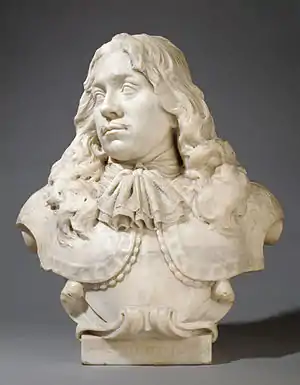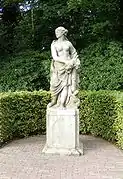Rombout Verhulst
Rombout Verhulst (15 January 1624 – buried 27 November 1698) was a Flemish sculptor and draughtsman who spent most of his career in the Dutch Republic. There he helped introduce the Baroque style in sculpture while becoming the leading sculptor of marble monuments, including funerary monuments, garden figures and portraits.[1]

(Latin inscription: Mea Sorte Contentus).
Life
Rombout Verhulst was born in Mechelen, where he studied with the sculptors Rombout Verstappen en Frans van Loo and possibly also Lucas Faydherbe.[2][3] It is assumed that between 1646 and 1654 he made a trip to Italy.[4]
In 1646 he moved to Amsterdam, where he worked under the Flemish sculptor Artus Quellinus on the decoration of the new town hall. His independent position among Quellinus' co-workers is apparent from the fact that he was the only one to individually sign works in this project.[3] At the Amsterdam town hall, he is known to have executed the reliefs of Venus, Fidelity and Silence for the galleries and terracotta studies for the bronze doors of the Vierschaar.[5] During the 1660s, Verhulst was able to rely on a network of private patrons in which the van Reygersbergh family played a pivotal role. In 1663 Verhulst completed a funeral monument for Maria van Reygersbergh in the church of Katwijk-Binnen. This was the first private commission for this type of work in the second half of the 17th century. His patronage shifted gradually from Amsterdam to The Hague.[6]
Around 1658 he moved to Leiden where he produced various sculptures for urban buildings and for tomb monuments. In 1663 he established himself in the Hague, where in 1668 he became a member of a guild. He died, aged 74, in The Hague.
He was the teacher of Jan Blommendael and Jan Ebbelaer.[4]
Work

Rombout Verhulst is best known for his many tomb monuments, but he made also portrait busts, garden sculptures and small-scale works in ivory.
His portrait oeuvre is rather small, which demonstrates that there was only a limited market for portrait sculptures in the Dutch Republic.[6] One of his best-known portraits is the marble bust of Jacob van Reygersbergh dated 1671, now in the Getty Museum in Los Angeles. A terracotta study for this work is in the Rijksmuseum and it differs from the marble version only in details.[7] This portrait bust shows Verhulst's virtuosity and the naturalism of his style. He removed any tendency to idealize the sitter in this work.[6] In his terracotta portraits he was able to create a living presence through his sensitive handling of the physiognomy and a correct evocation of the sitter's personality.[5]
Verhulst is mainly remembered for this many tomb monuments for private and public patrons. His funeral monument for Maria van Reygersbergh of 1663 established his reputation in this area with its new and imposing style. He made many church monuments erected to commemorate Dutch naval heroes.[6] His chief work in this area (though possibly not his most successful creation) is the decorated tomb of the Dutch naval hero Michiel de Ruyter in the Nieuwe Kerk in Amsterdam.
In addition to the monumental commissions he completed, Verhulst made small-scale ivory carvings, a specialty for which his home town Mechelen was particularly known. A small ivory Virgin and Child held in the Rijksmuseum shows his skill in this regard. He has carved the thick, wavy locks of hair of the chubby Christ Child and the heavy drapery with such realism that they appear almost tangible.[1]
Although his style was indebted to Artus Quellinus, he did not completely adopt Quellinus' classicist tendencies. Verhulst's work is warmer in conception and executed with greater refinement and therein resembles more that of the Antwerp sculptors from the circle of Peter Paul Rubens, including Hans van Mildert and Lucas Faydherbe.[3] His work was usually more realistic than that of Quellinus and is less dramatic.[6]
Selected works

- A "Venus and the swan" and portrayals of Modesty and Good Faith (Getrouwheid) (Ca. 1654) In the galleries of the Amsterdam city hall in Amsterdam
- The decorated tomb of Jan van Galen (About 1655) In the New Church in Amsterdam. The design is by Artus Quellinus, the sea-battle scene (zeeslag) by Willem de Keyser.
- The tomb of Maarten Harpertszoon Tromp (Completed 1656) In the Oude Kerk in Delft. The design is probably by Jacob van Campen and the sea-battle scene by Willem de Keyser.
- The sculpture at the Waag (1657) In Leiden
- The relief, representing the plague in the form of a Fury (1660), above the gate of the plague house in Leiden
- The epitaph for Pieter van der Werff (1661) in the Hooglandse Church, Leiden
- The lion above the gate at the base of the Burcht at Leiden (1662)
- The decorated tomb for Willem van Lyere and Maria van Reigersberch, at the Dorpskerk at Katwijk aan den Rijn
- The tomb for Johan Polyander Kerkhoven (1663) in the Pieterskerk, Leiden
- The decorated tomb of Carel Hieronymus van In- and Kniphuisen (1665–69) in the church at Midwolde
- The epitaph for Hendrick Thibaut and his wife and daughter (1669) in the church of Aagtekerke
- The epitaph for schout-bij-nacht Willem van der Zaen (1670) in Amsterdam
- The epitaph for Theodor Graswinckel (1670) in the Grote Kerk at the Hague
- The epitaph for Johannes of Gheel (ca. 1670) in the church at Spanbroek
- The tomb for Adriaan Clant (1672) in the church at Stedum
- The epitaph for Isaac Sweers (1674) in the Oude Kerk at Amsterdam
- The tomb monument for Hieronymus Hieronymus van Tuyll van Serooskerken (ca. 1675) in the church at Stavenisse
- The decorated tomb for lieutenant-admiral Willem Joseph van Ghent (1676) in the Domkerk in Utrecht.
- The tomb of Michiel de Ruyter (completed 1681) in the Nieuwe Kerk in Amsterdam
- The tomb monument for Johan and Cornelis Evertsen (1680–82) in the Wandelkerk in Middelburg
Gallery
 Tomb monument of Michiel de Ruyter in Amsterdam
Tomb monument of Michiel de Ruyter in Amsterdam Tomb monument of Johan Polyander van den Kerckhove (1594-1660) in Leiden
Tomb monument of Johan Polyander van den Kerckhove (1594-1660) in Leiden
 Statue Flora in St. Hubertus
Statue Flora in St. Hubertus

References
- Rombout Verhulst, Virgin and Child at the Rijksmuseum
- "Rombout Verhulst". kunstkubus.nl.
- Cynthia Lawrence. "Verhulst, Rombout." Grove Art Online. Oxford Art Online. Oxford University Press. Web. 15 Feb. 2014.
- Biographical details at the Netherlands Institute for Art History (in Dutch)
- Sheila D. Muller, Dutch Art: An Encyclopedia, Routledge, 4 July 2013, p. 432
- Frits Scholten, "Mea Sorte Contentus": Rombout Verhulst's Portrait of Jacob van Reygersberg, in: 'The J. Paul Getty Museum Journal: Volume 19, 1991', The J. Paul Getty Museum Getty Pub, p. 65-74
- Portrait of Jacob van Reygersbergh at the Rijksmuseum
| Wikimedia Commons has media related to Rombout Verhulst. |
Further reading
- Marinus van Notten: Rombout Verhulst, Beeldhouwer, 1624-1698. Een Overzicht Zijner Werken. Den Haag 1907